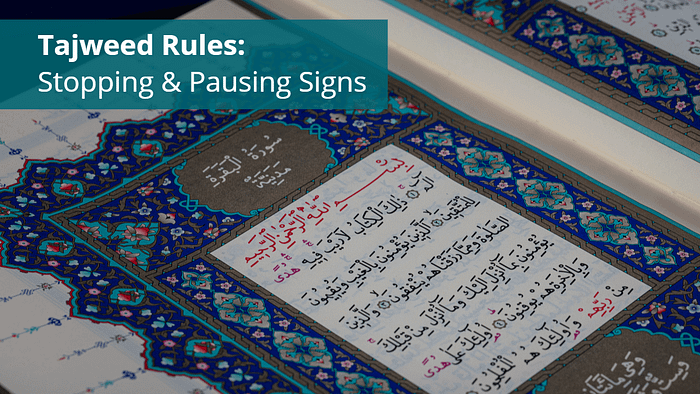Blogs
Introduction
Tajweed is the art of reciting the Quran with precision and perfection. It involves a set of rules and guidelines that govern the pronunciation, articulation, and melodious recitation of the holy Quran. In this article, we will explore a crucial aspect of Tajweed rules related to stopping and pausing while reciting the Quran. Whether you’re a seasoned reciter or just beginning your journey, understanding these rules is essential to enhance your Quranic recitation.
The Significance of Stopping and Pausing in Quranic Recitation

Before delving into the specifics of stopping and pausing signs in Tajweed, it’s crucial to understand why they are so significant. Properly observing these signs helps maintain the intended meanings of the verses and preserves the rhythm and melody of the Quran. It ensures that the words and verses are recited in a harmonious and melodious manner, allowing the listener to grasp the profound meanings of the Quranic text.
Types of Stopping and Pausing Signs
Tajweed rules define various types of stopping and pausing signs that guide the reader during recitation. These signs are known as “Waqf” and play a crucial role in how the Quran is recited. They range from simple pauses to longer stops, each with its own rules and implications for recitation.
Recognizing Stopping Signs in the Quran
To apply Tajweed rules effectively, it’s essential to recognize the stopping signs within the Quranic text. These signs are notated in the script and are fundamental to maintaining proper recitation. Understanding where and how to pause is a skill that requires practice and dedication.
Rules and Guidelines for Proper Pause and Continuation
To master Tajweed, one must adhere to specific rules and guidelines for pausing and continuing the recitation. These rules cover when to pause, how to pause, and when to take a breath. They ensure that the Quran is recited accurately and beautifully.
Common Mistakes to Avoid in Tajweed
Mistakes in Tajweed can alter the meaning and beauty of the Quranic recitation. Avoiding these common errors is vital for anyone committed to mastering this art. We’ll explore some of the most frequent mistakes that reciters encounter and how to correct them.
Benefits of Applying Tajweed Rules in Quranic Recitation
Applying Tajweed rules when reciting the Quran brings numerous benefits. It not only enhances the beauty and eloquence of the recitation but also deepens one’s connection to the Quran and its message. We’ll delve into the advantages of adhering to Tajweed rules in your recitation.
Practicing Tajweed: Tips and Resources
Improving your Tajweed skills requires practice and dedication. We’ll provide practical tips and recommend resources, including online courses and websites like Studio Arabiya, to help you refine your Tajweed skills.
Conclusion
In conclusion, Tajweed rules, including those related to stopping and pausing in Quranic recitation, are a fundamental aspect of reciting the Quran with precision and beauty. By understanding the significance of these rules, recognizing the stopping signs, following the guidelines for proper pausing and continuing, and avoiding common mistakes, you can enhance your Quranic recitation. The benefits of applying Tajweed rules go beyond pronunciation — they deepen your connection to the divine message. So, embark on your Tajweed journey and unlock the true beauty of the Quran.
Posted in: Education
Topics:
tajweed rules
Be the first person to like this.






